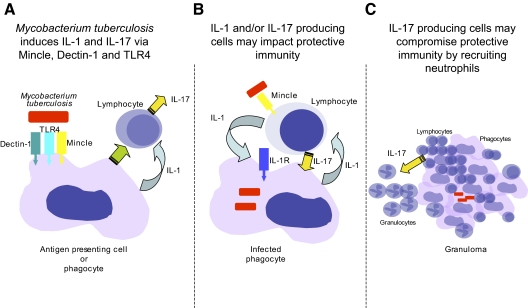Figure 1.
The role of IL-17 in protective immunity to Mtb is still being determined. (A) We know that IL-17 can be produced by human peripheral blood cells with no known exposure to mycobacterial antigens in response to Mtb. This IL-17 response is dependent on signaling through lectins and IL-1R. (B) In the absence of IL-1 or IL-17, mice are more susceptible to Mtb infection; it is not clear which cells producing IL-1 or IL-17 are the most important nor what they are actually doing to mediate protection. Development of the granuloma may be one aspect of the protective response mediated by IL-17. (C) If antigen-specific, IL-17-producing T cells are induced, then, they may compromise immunity in the long-term, as they will promote neutrophil accumulation in the mononuclear granuloma. Even nonantigen-specific T cells may be stimulated to produce IL-17 in the presence of extracellular bacteria, as the newly described receptor for trehalose dimycolate, a major surface molecule of Mtb, is Mincle, and this is expressed by T cells (B).

